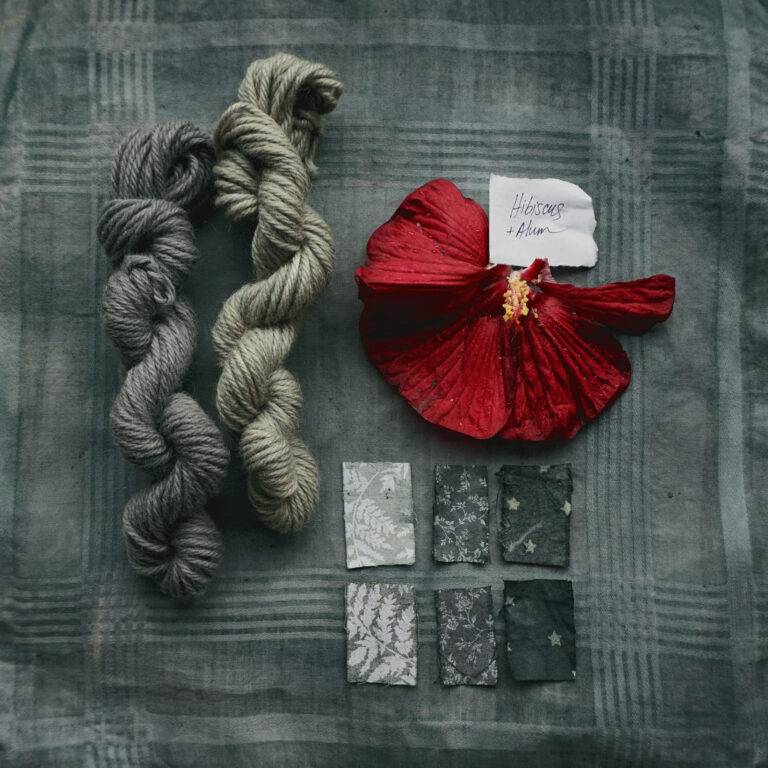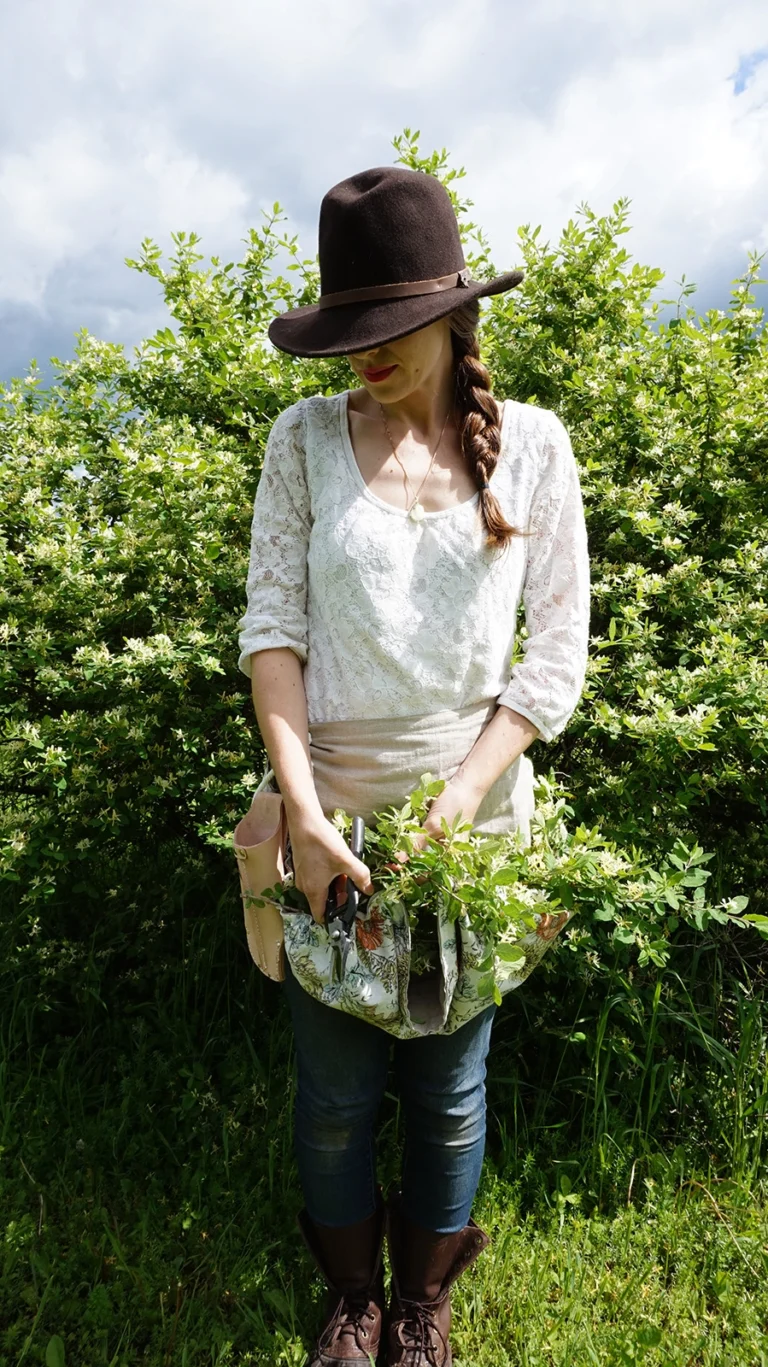My oldest sister used to have this deep peachy pink hibiscus plant that traveled along with her from school to her first apartment and I always remembered that plant as Kate’s plant. It fit her and it seems to me even being quite a bit younger and not really knowing how to take care of plants myself, she doted on it a lot. If I look back at pictures, shots taken as a family at her first apartment, I’m sure it was sitting proudly in the background. It always seemed so easy going too. Basking on her sunny balcony in the warm months and lovingly brought in when the chills of New York’s colder fall weather meant winter would slow the blooms for a while.
I’ve read for a few years about the dye potential in hibiscus and it felt tempting, but with all the harvesting I do with invasive species, dyeing with a cultured plant is an interesting change when you can convenient watch it from your porch.

Like so many dyes (whether in instant package form, food coloring or extracted from plants) there are so few plants that take on the same color as the dyestuff itself.
Hibiscus has been long touted as a dye ingredient in India for the climate and because they are avid dyers, used for all things from coloring food, shoe polish and hair dye. Little wonder really when it is so water soluble and bonds easily. As a anthocyanin dye it is both sensitive to heat and PH but this particular dye seemed to be pretty resilient. Sometimes the solubility is not the issue with anthocyanins but the ability to bond to fiber can be tricky as I find in failing time after time with the elusive Hopi Amaranth (refusing to use tin). But here this isn’t the case, and unlike Amaranth, this is a fast dye. Within several minutes of placing these gorgeous leather/crepe flowers in water you will see dye releasing in a slithering path. Within an hour a good deal of color has already left the flower.
And like so many dyes (whether in instant package form, as food coloring or extracted from plants) there are so few plants that take on the same color as the dyestuff itself. I certainly have much more experimenting with this plant and hope I’ll be able to collect enough before the blooming season is up as you can get this color, but I wanted to get some blues if I could.
HOW TO MAKE
Since the plant I bought had an absurd amount of blooms (someone did a wonderful job pinching this baby), I have an average of 6-8 blooms a day. It really didn’t take me very long to harvest enough for a test. I have quite a few handy cardboard berry pints that I dry my flowers in so this is part of my ready stash when I’m looking to measure out what I have. I soaked the flowers the night before. Once I had the time to cook them up they were probably soaking about 12 hours. I had scoured this really lovely vintage Ironstone wool yarn in the method I’ve recently published in this guide (here) but I did not mordant the wool. Hibiscus for whatever reason does not need a mordant according to some quoting Jenny Dean, though I can’t find her words on this at all (and I think she’s amazing so her word is gold to me!). Nevertheless, according to scientific research journals I’ve read on anthocynanins and Hibiscus, alum and iron do help in fastness with mention of tin (which I will never use) so I decided I’d rather have a smaller portion than nothing.
I really couldn’t ascertain what other people use in terms of weight of goods (WOG) ratio, but the rule of thumb for protein fibers is about 2:1 dyestuff to fiber and cellulose 4:1 so I went by that. In the end it was probably 2.5:1 flowers to wool. The blooms of my plant are really large and pretty heavy so you’ll have to measure what you have. There may be a point of absorption where more won’t mean more.
INTENSIFY
Vinegar is often associated as the best type of modifier for pinks and purples but even while adding a little in the beginning simmer I could tell the amount of color in the goo (with the fiber) it was not bonding as I figured should with the color I was seeing in the pot. It was pretty but I thought I could do better. During the extraction process (almost always with the fiber “cooking with the dyestuff”) I use alum as a color booster, whereby it seems to behave as a PH modifier (raising the PH). Not only does it provide that boost I’m looking for but also help with bonding. I first noticed this in dyeing with goldenrod. It first foams when only a pinch of alum is added (don’t panic) it then intensifies in color. I generally undermordant fabrics (if at all since I use protein milks and clay to mordant), but because I often use modifiers in the dyebath, particularly alum, I thought I’d try this with the wool.
Because the dyebath was already hot and I can’t take a hot reading with my PH meter I can’t tell how much it jumped. When done in the past, with other dyestuff cold, it usually jumps a couple levels. I only like to know this information when curious but especially with protein fibers since I don’t want to damage it with heating an alkali. I added a couple pinches essentially of alum and pow, the color intensified to a deep purple and almost immediately the wool sucked the pigment like a sponge.

When I felt the color had worked it’s way in evenly (probably about 5 minutes) and was a little too purple I tried to reign the PH back (hoping to regain that pink) by lowering it with a considerable amount of vinegar, but from what I’ve seen in the past, lowering the PH with safe modifiers like vinegar doesn’t budge enough. Here’s is where I’ll do more testing, no alum and more soaking perhaps? I was watching my temperature as I didn’t really want to get above 160ºF, but I saw no indication that the color was going to get anywhere close to dulling and so I will do more testing here to see what is really is the tipping point. I know in dyeing with Bee Balm the heat doesn’t seem to bruise the color.
As you can see from this shot, it’s pretty lovely, a pinkish lavender but so often with the anthocyanins, the color will deepen and you’re left with bluer tones. There are so few dyes that produce blues so that was fine by me!
This year I’m trying to be pretty diligent about capturing my tests in a picture journal. I have a few written dye journals but this one will include more swatches, sketches and pressings. There never seems to be time for it but it is a much more portable version to show trials than shelves of yarn and fleece and fabric to carry around in my car. I have yet to try on silk (simply forgot to take a cut), but I have no doubt it will perform as nicely as saturated pinks and purples from bee balm, dark opal purple basil and Vitis Riparia (river grape) have on silk. Gorgeous in fact. In the case of cotton, Hibiscus just took to it with a sincere and deep affinity. The smaller swatches are more in keeping with the dyebaths added at the same time as the skeins of wool yarn. For a larger example and to show what happens with the color change I threw in my soy mordanted vintage handkerchiefs I use for testing.

See that greenish-blue color? That is nearly dry and that’s what it’s going to ultimately look like with this alum boost. The pinks and purples show the color you’ll first see when you pull out your cloth if you’ve raised the PH. Do I wished I could have kept the purple? Oh of course, but more experimenting and overdyeing might accomplish this. The prairies are my playground for more dyeing! Those blobby specs are the flower materials themselves. I dye with the plant, simultaneously unless I want a really solid cloth. Sometimes I’ll cordon off the dyestuff in a little sack but I’m always conscious of the amount of energy I’m using and since I dye a lot, I’d opt for less heating to stretch my energy source.
I did find that the soaking time seemed to effect them in the opposite way. Where the first bath was stronger with the wool, longer colder soaks for the cotton cloth made the color deeper. Heat probably isn’t required and I’ve found that with Bee Balm and other pinks that seems to be the same for fabric but doesn’t seem to help for wool. I think it does help to get it started, probably pulling sugars out of the flowers a bit more (it is in the Mallow family after all) but heating the cotton cloth longer isn’t necessary.

Cotton from left to right: 1st dye bath (top row): no mordant, soy mordant, soy mordant + iron; (bottom row): no mordant, soy mordant, soy mordant + iron.
Get busy livin’ and get busy dyein’.


4 thoughts on “Natural Dyeing with Hibiscus Using Alum as Modifier”
This is beautiful and helpful, thank you. Planning to try my first batch of wool fibre and handspun cotton with some dark pink hibiscus. Enjoyed the post and pictures!
That’s great! Ah, handspun 🙂 there’s just nothing more handsome than that, is there? You’re making me want to hop on my wheel now and spin 🙂
Thanks, Prachi. I’m sure you could premordant with alum but I do often simultaneously mordant while it’s "cooking" (mostly because it cuts an energy step out) and that’s what sort of tipped me off with the deep colored mallow plants that this might be the key. From what I understand about petrology, alum in itself is acidic but once water is added the PH is raised. I was just about to do a quick reading for you but I can’t seem to find my PH reader. The colors are still holding pretty well but it’s only been a year. If nothing else it’s a lovely use of such a generous flowering plant. I’d love to know how you make out. Look out for walnuts too. You’ll have a ton of fun with that this time of year, and goldenrod. They both smell amazing too.
*As a last note, know that you’ll need to scour and mordant your protein (wool) and cellulose (cotton) fibers differently. I always do legumious solutions for my cellulose fibers (ie. soy). If you have questions I’m always happy to share my tinkering.
have you tried this with cotton fibers?
Hi Amanda, yes, I’ve included details on both cellulose and protein fibers in this post. Let me know if you have questions.